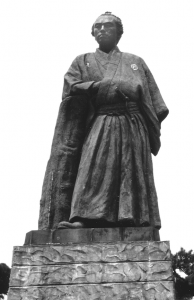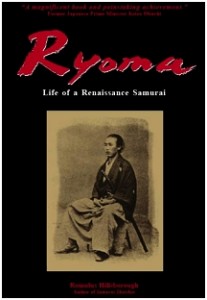“. . . we are going to have to learn more than just the arts of war.” [将来は武のみを以て立つべからず、学問が必要なり。]
The United Nations states on its website: “The development of International Law is one of the primary goals of the United Nations.” Sakamoto Ryoma, the “Renaissance Samurai” of my historical novel Ryoma, also had a high regard for international law. Ryoma of course never left Japan and his progressiveness is all the more remarkable when you consider that he lived his entire short life in a highly structured, repressive feudal society under the Tokugawa Shogunate, which ruled the country under a policy of isolationism from the outside world for over two centuries.

Which highlights the enigma presented by his pose in the ubiquitous standing photograph, upon which the famous bronze statue is modeled: What does he hold in his right hand, concealed inside his kimono? Is he holding the Smith & Wesson revolver that the political outlaw used to defend himself in the nearly fatal attack by a Tokugawa police force? Or is it a book on international law, by which he defeated his political enemies (representatives of the Tokugawa clan) in a legal battle during the final year of his life? The question underlies the following famous anecdote from Chikami Kiyomi’s 1914 biography, included in my Samurai Tales (Tuttle 2010), which, regardless of its authenticity, informs the development of Ryoma’s character: from an anti-foreign swordsman advocating violent revolution to the founder of Japan’s first trading company and author of a peace plan to prevent civil war:
One day the outlaw Sakamoto Ryoma encountered a friend in the streets of Kyoto. The man wore a long sword at his side, as was popular during those bloody days. Ryoma took one look at the sword, and said, “That sword’s too long. If you get caught in close quarters you won’t be able to draw the blade.” Showing the man his own sword, Ryoma said, “This is a better length.”
Soon after, the man replaced his long sword with a shorter one, and showed it to Ryoma. Laughing derisively, Ryoma produced a pistol from his breast pocket. He fired a shot in the air, and with a wide grin on his face said, “This is the weapon I’ve been using lately.” The two friends met again some time later, when Ryoma took from his pocket a book of international law. “In the future,” he said, “we are going to have to learn more than just the arts of war. I’ve been reading this recently, and it is so very interesting.”
For updates about new content, connect with me on Facebook.

Ryoma: Life of a Renaissance Samurai, the only biographical novel about Sakamoto Ryoma in English, is available on Amazon.com.
